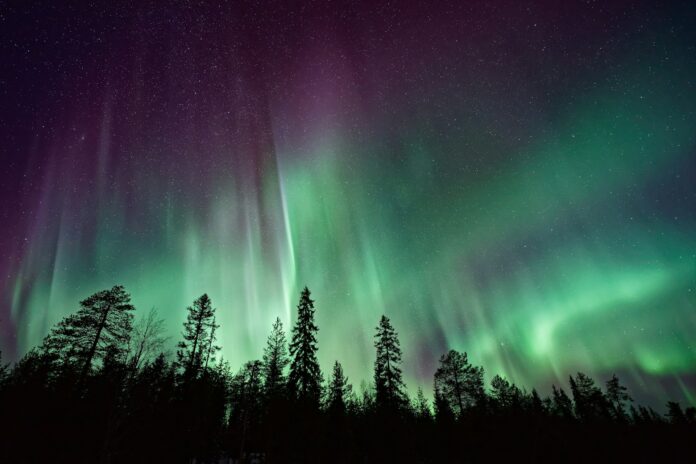Following last week’s stunning display, another eruption of the sun may bring aurora borealis to Britain
The northern lights could once again light up the skies over Britain this week, according to the Met Office. Following last week’s spectacular display, which saw vibrant purple and green lights over areas as far south as Yorkshire and Essex, another solar eruption may make the aurora visible again.
On May 11, the northern lights were visible over the outskirts of London, creating a rare and stunning sight for residents. The Met Office Space Weather department has indicated a slight chance of Coronal Mass Ejection (CME) impacts overnight on May 17 into May 18. This could enhance the aurora and potentially make it visible as far south as northern Scotland.
However, the Met Office cautions that this week’s display may not be as spectacular or widespread as the previous one. Background aurora conditions are expected, with only limited enhancements anticipated. The app Aurorawatch, run by the Space and Planetary Physics group at Lancaster University, has issued an Amber Alert, suggesting that auroras might be visible in northern latitudes.
The best time to see the northern lights this week will be on Friday night. For optimal viewing, one should head to areas away from light pollution and face north. North-facing coasts often provide the best locations for viewing. Clear, dark skies are essential for seeing the aurora borealis.
Modern mobile phone cameras are highly capable of capturing the northern lights, often better than the naked eye. Using night mode on phones like the iPhone can yield impressive photos by taking several shots and combining the best parts into one image. This feature can make faint auroras appear more vibrant in pictures.
Last week’s northern lights display was particularly notable, with the skies over the UK illuminated in brilliant pink and green hues on May 10. The display was visible in Scotland, Wales, Northern Ireland, and even southern England. This event followed a severe solar storm warning issued by America’s National Oceanic and Atmospheric Administration (NOAA), the first of its kind since 2005. The storm raised concerns about potential interference with satellites and the power grid.
Coronal Mass Ejections (CMEs) are large clouds of solar plasma and magnetic fields released into space after a solar eruption. When these CMEs hit Earth’s atmosphere, they can create stunning northern lights. These ejections stretch over millions of miles and are capable of producing significant auroras when they interact with our planet’s magnetic field.
In the event that the northern lights are visible again this week, it will provide another opportunity for residents across the UK to witness this natural phenomenon. The anticipation for another display is high, especially following the awe-inspiring spectacle of last week.
Analysis:
The potential reappearance of the northern lights in the UK this week highlights the fascinating interplay between solar activity and Earth’s atmospheric conditions. From a scientific perspective, Coronal Mass Ejections (CMEs) and their effects on Earth provide critical insights into solar-terrestrial interactions. These events underscore the importance of monitoring space weather, as CMEs can impact not just auroras but also satellite operations and power grids.
Economically, the northern lights present a unique opportunity for tourism, particularly in northern regions of the UK. Areas known for their dark skies, such as parts of Scotland, can attract visitors seeking to witness the aurora borealis. This can boost local economies, particularly in rural areas where tourism might otherwise be limited. The northern lights can also spur interest in space science and related educational activities, potentially inspiring future generations of scientists.
Sociologically, the widespread interest in the northern lights reflects a collective fascination with natural phenomena. The event serves as a reminder of our connection to the broader cosmos and the forces that shape our environment. Public interest in such displays can foster a sense of community, as people gather to share in the experience. Social media platforms, where many share their photos and experiences, amplify this communal aspect, spreading awe and wonder across digital spaces.
From a local perspective, the visibility of the northern lights over urban areas like London is rare and extraordinary. Such events can enhance public appreciation for natural beauty and the need to reduce light pollution. They also offer a respite from daily urban life, providing a moment of wonder and reflection.
Theologically, the northern lights have historically been imbued with cultural and spiritual significance. Various cultures have myths and legends associated with the aurora borealis, seeing them as manifestations of the divine or spirits. In modern times, while scientific explanations prevail, the lights continue to inspire a sense of wonder that can be seen as a spiritual experience.
Lastly, the anticipation of another potential display this week highlights the role of technology and communication in shaping public expectations. Real-time alerts and forecasts from institutions like the Met Office and apps like Aurorawatch enable people to prepare and plan for optimal viewing experiences. This accessibility to information enhances public engagement with natural events.
Overall, the possible return of the northern lights this week is not just a meteorological event but a multifaceted phenomenon with scientific, economic, sociological, local, and spiritual implications. It underscores the beauty of our natural world and the ongoing interplay between human activity and the cosmos.
